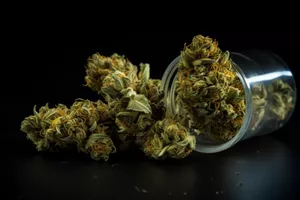
Durban Poison Cannabis Strain
Your Cannabis AI assistant
*By signing up, you agree to the Terms and Conditions and Privacy Policy. California residents, see our CA Privacy Notice.
Unlock the full potential of Durban Poison Cannabis Strain
Durban Poison originated from Durban, a South African port city, and is sold by Dutch Passion Seed Company. It typically has an impressive nineteen percent THC and one percent CBD. This particular strain is a pure Sativa, which makes excellent parent strains.
These south African seeds produce an herbal flavor and aroma with hints of pine and sage. Durban Poison's buds have many trichomes. Durban Poison is an excellent Sativa strain for edibles, promotes creative qualities, and provides better focus than many other strains.
What is a strain?
Cannabis strains are considered to be a pure or hybrid genetic variation of the plant Genus Cannabis. There are three main species: Cannabis Sativa, Cannabis Indica, and Cannabis Ruderalis.
Ruderalis is not as popularly known as the others; however, it is a derivative of cannabis with the lowest THC levels.
Although they are popular among the cannabis community, hybrids are not considered a species as they are made of Sativa and Indica, with typically one or the other dominating the gene pool.
For marketing and medical marijuana purposes, cultivators will develop a cannabis strain to highlight specific desired characteristics, such as:
Color
Density
Flavor profile
Aroma
Medicinal benefits
Psychoactive effects
Cannabinoid percentages
THC vs. CBD content
Those within the cannabis community report that there are close to eight hundred unique weed strains worldwide, but that number has increased steadily throughout the years.
It's important to remember that all of them originated from landrace strains that were imported at some point in history.
Different strains are created yearly as botanists experiment with crossing classic marijuana strains with hybrids to change their genetic qualities.
Landrace Marijuana Strain History
The word landrace originates from the Danish language and means "origin." Landrace strains are the oldest known strains in the cannabis world.
They traveled from the Himalayan and Hindu Kush mountains worldwide and have become the parent strains to many well-known hybrids we use today.
Most modern strains in cannabis culture are hybrid, meaning they were selectively produced for desirable genetic qualities such as terpene production, cannabinoid preferences, and THC potency.
People illegally smuggled the cannabis plant into North America from outside countries in previous generations for decades.
Landrace Sativa strains came from regions such as Thailand, South Africa, and Mexico, while landrace Indica strains originated from Afghanistan and India. Many classic and rare landrace strains got their names from the area of their origin.
Durban Poison Marijuana Strain
The Durban Poison strain is one-hundred percent pure Sativa from the South Coast of Africa. It's organic, simple, and yet a heavy hitter that is popular in the medical and recreational consumer market.
Flavors
It tastes of sweet licorice, citrus, fennel, and spice, with a flavor profile that lingers in your mouth after each exhale.
Aroma
Durban Poison marijuana has a unique aroma that is both sweet and spicy. Rather than artificial smells, this Sativa strain has a subtle fragrance reminiscent of walking through a forest.
Physical traits
Durban Poison marijuana strain buds are chunky, large, and filled with resin glands. These icy green buds are covered in sticky trichomes and orange pistils.
Medical Benefits
Durban Poison is a versatile strain that has many medical benefits. It can treat anything from severe medical conditions to mild sleep disorders, muscle spasms, panic attacks, anxiety issues, mood disorders, migraines, epilepsy, and more.
Potential Side Effects
There are many medical benefits to using Durban poison strains, but if you smoke regularly, due to THC content, you could notice adverse effects such as:
dry mouth
dry eyes
anxiety
paranoia or hyper-awareness
fatigue
The THC content of Durban Poison Weed
The THC levels of Durban Poison marijuana can reach up to twenty-five percent, however, it usually averages around nineteen percent.
Durban Poison Review- Growing
The Durban Poison plant is a pure Sativa cannabis strain. Female and male fertilizing plants do well outdoors in a warm and sunny place with no frost. It is resistant to pests and mold and grows very tall. Approximate yield: sixteen ounces
Flowering Time
A healthy Durban Poison plant has a flowering period of eight to nine weeks indoors and is usually ready for harvest time in early October when grown outdoors.
Cannabis Sativa
Cannabis Sativa does well in warmer regions of the Earth and can thrive with high humidity levels. The typical locations where Sativa strains are grown are Central America, South America, and Southeast Asia. Sativa is tall and slender with thin, light green leaves.
Many people report that smoking Sativa makes them feel energized, creative and focused. These psychological effects make Sativa strains best for daytime use because using them at night may cause insomnia due to the higher THC levels.
There are many reasons people use Sativa cannabis strains, including:
Easing depression symptoms
Headache and Pain relief
Decreasing Nausea
Fighting appetite loss
Better Focus
Head High over Body High
What's the average price for Durban poison buds?
Depending on your location and the quality of the buds, Durban Poison usually goes for around twelve dollars a gram in U.S. dispensaries.
Popular Strains Similar to The Durban poison Strain
Final Thoughts on Durban Poison Cannabis Strain
Durban Poison is a landrace strain that has been modified and improved over time. It is now one of the most popular strains of all time and has been around for a very long time. While it may not have a complex genetic lineage, the taste and flavor combined with potency make this one a repeated buy for many cannabis users worldwide.
A Journey into the Diverse World of Strains
Types of Cannabis Strains:
Cannabis strains are generally classified into three main types, each with distinct characteristics and effects:
- Indica: Known for their relaxing and calming effects, Indica strains are often favored for evening use, stress relief, and relaxation. They are typically associated with a "body high" and may promote physical relaxation and sleep.
- Sativa: Sativa strains are known for their uplifting and energizing effects, making them popular for daytime activities, creative pursuits, and socializing. They tend to produce a more cerebral or "head high" and may stimulate creativity and focus.
- Hybrid: Hybrid strains are a combination of Indica and Sativa genetics and offer a balance of effects. They are available in various ratios (e.g., Indica-dominant, Sativa-dominant, or balanced) and may exhibit characteristics of both parent strains.
Cannabinoids and Terpenes:
Cannabis plants contain a variety of chemical compounds called cannabinoids and terpenes that contribute to the strain's effects, flavors, and aromas:
- Cannabinoids: The most well-known cannabinoids are THC (tetrahydrocannabinol) and CBD (cannabidiol). THC is responsible for the psychoactive effects of cannabis, while CBD is non-intoxicating and may have therapeutic properties. The ratio of THC to CBD in a strain can influence its overall effects.
- Terpenes: Terpenes are aromatic compounds found in cannabis and other plants. They give each strain its unique scent and flavor profile (e.g., citrusy, earthy, fruity) and may also influence the strain's effects.
Choosing the Right Strain:
Selecting the right cannabis strain depends on individual preferences and desired effects. Consider the following factors when choosing a strain:
- Desired Effects: Consider the type of experience you're seeking, whether it's relaxation, pain relief, creativity, or socializing.
- Tolerance: If you're new to cannabis or have a lower tolerance, consider strains with lower THC levels or strains with a balanced THC-to-CBD ratio.
- Medical Conditions: If you're using cannabis for medical purposes, specific strains may be more suitable for addressing particular symptoms or conditions.
Responsible Consumption:
Cannabis affects everyone differently, so it's important to consume responsibly and start with a low dose, gradually increasing as needed to find your ideal experience. Be mindful of the method of consumption (e.g., smoking, vaping, edibles) as it can impact the onset and duration of effects.
Legal Considerations:
Familiarize yourself with local cannabis laws and regulations regarding marijuana use, possession, and purchase. Laws vary by location, and it's important to ensure compliance.
Remember, the information provided in this section is intended to serve as a general guide. Consult with a cannabis healthcare professional for specific medical concerns, and always verify the legality of cannabis in your location.











